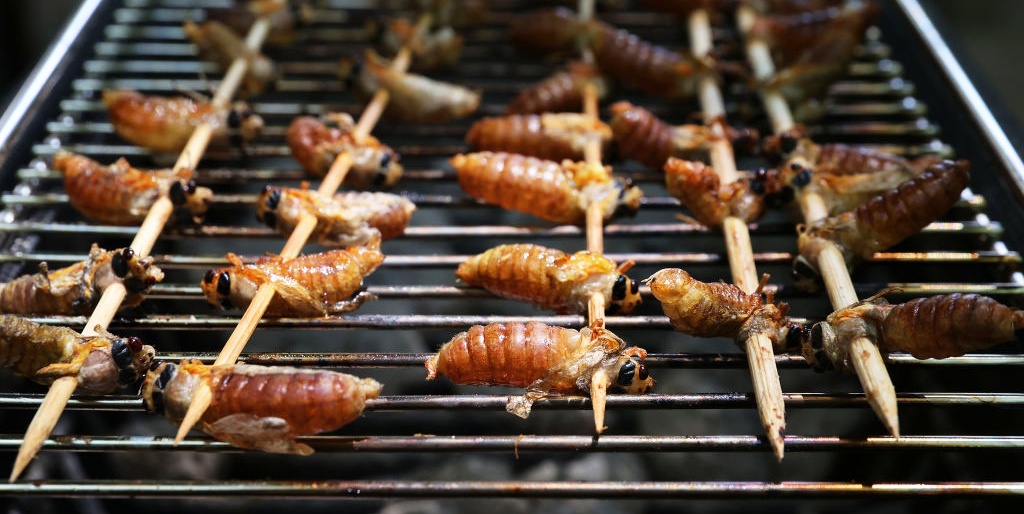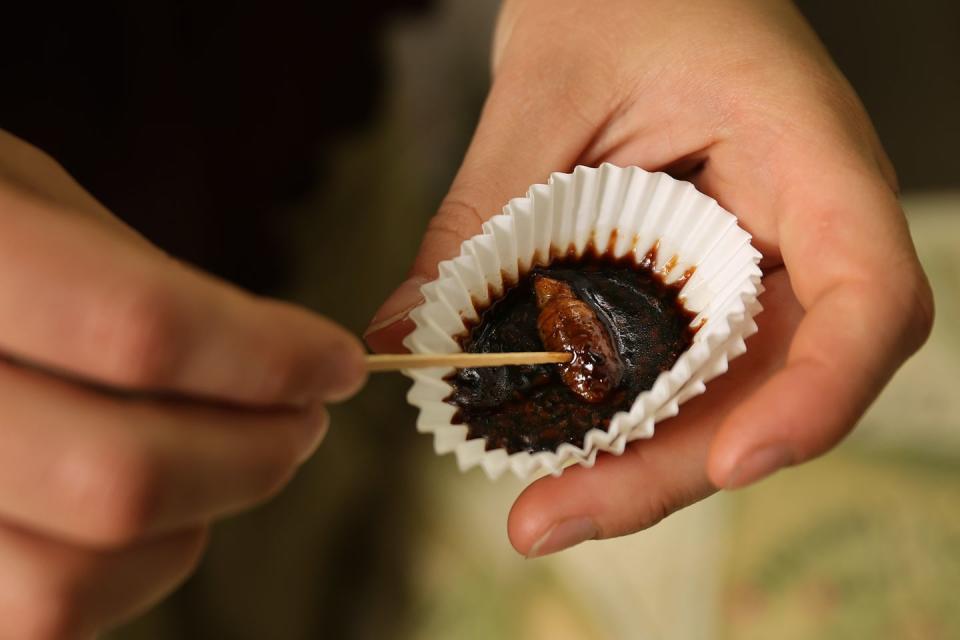Should You Eat Cicadas? Here’s Why (and How) People Snack on the Insects

You should avoid eating cicadas if you have a seafood allergy, the FDA warns.
Otherwise, cicadas are edible. In fact, many parts of the world eat insects.
Scientists say cicadas are actually a sustainable form of protein,
Periodical cicadas from Brood X are coming out by the millions in parts of the eastern United States. And even though they create a ton of racket, cover countless trees, and craft their own chimneys, some people actually think cicadas make a pretty great snack, if you know how to prepare them.
But before you start collecting the bugs, be aware of the risks: The U.S. Food and Drug Administration does not recommend consuming cicadas if you have a seafood allergy, as cicadas are actually pretty similar to shrimp and lobsters and could potentially cause a reaction.
If you’re inundated with cicadas and have an adventurous palate, it might be time to consider a new kind of protein. Here’s everything you need to know about why people eat the loud insects, plus tips on how to do it yourself.
So, why do some people eat cicadas?
In the United States, we’re socialized to think of bugs (especially giant ones like cicadas) as nasty—definitely not something to eat. But if you come at it from another perspective, cicadas are like a huge surplus of free food that you don’t need to buy at the store.
The bugs are a great source of sustainable protein, according to Akito Y. Kawahara, Ph.D., associate professor and curator at the Florida Museum of Natural History at the University of Florida. Producing meat like beef requires a great deal of land, feed, and emission, contributing to climate change; insects like cicadas, meanwhile, are a source of food without all that baggage. “These are opportunities that we should probably take advantage of,” he says.
There is limited nutritional data on cicadas, but experts suspect it is similar to that of other insects, offering plenty of protein with relatively few calories. Bugs also offer healthy amounts of fiber, fat, vitamins, and minerals, per an expansive United Nations (UN) report from 2013—and cicadas are likely no exception.
How do you cook a cicada, exactly?

The question, really, is how you can’t prepare a cicada—the insects are about as versatile as food comes. Young cicadas, called tenerals, are generally best to eat because their bodies haven’t hardened yet, according to the cookbook Cicada-licious: Cooking and Enjoying Periodical Cicadas, which was published by University of Maryland graduate students in 2004, the last time Brood X emerged.
To find tenerals, Cicada-licious explains, search on tree trunks in the very early hours of the morning and look for white-green bugs, placing them in a paper bag as you go. Cooking them immediately or refrigerating them keeps their consistency intact, but freezing them is the most humane way to kill the insects. Before you cook them (usually by boiling, blanching, frying, or roasting), remove hard parts like wings and legs, which don’t add any flavor.
From there, go wild! Cicada-licious recommends eating the insects in everything from dumplings to banana bread. TikTok users have been getting creative, too, serving cicadas fried in tempura batter, alongside chips and dip, and rice with veggies. In his college days, Kawahara himself ate cicadas in sushi and pasta, in which the bugs became an “earthy version of shrimp.”
What do cicadas taste like?
Like other proteins, cicadas take on a rich flavor when cooked. Home chefs on social media describe the taste as buttery or nutty—better than you might expect from an insect. One TikTok user describes the taste of boiled cicadas as akin to fiddleheads, while roasted cicadas take on a nuttier flavor.
Is eating bugs safe?
In short, yes. Although they aren’t a common part of the American diet, insects are a staple in tons of other places; at least 2 billion people worldwide regularly consume bugs in their diets, and more than 1,900 insect species have reportedly been used as food, according to the UN report.
People eat insects just about everywhere, from Mexico to Australia to Thailand, “both as a delicacy and staple,” per Cicada-licious. Cicadas, specifically, are also a cherished ingredient of some regional Chinese cuisines, Kawahara says, where tenerals are harvested and added to dishes like stir-fries.
You’re also probably eating bugs without knowing it, since bits and pieces of insects inevitably end up in the food we eat. Carmine, one of the most commonly used red food dyes, is made from crushed beetles. Again, exercise caution before indulging in cicadas if you have a seafood allergy.
There is also very little chance that eating cicadas, particularly periodical cicadas, will impact their survival, Kawahara explains: “There are just so many that I don’t think small amounts of eating them is going to really affect anything,” he says.
Bottom line? “There is no reason why we should not be eating insects,” explains Kawahara, who hopes we can stop thinking of bugs as gross. “If you think of it from a different perspective, the fact that we drink cow’s milk—which is coming out of the breast of a cow—it’s pretty gross, I think.” Food for thought!
You Might Also Like